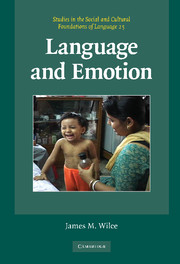Book contents
- Frontmatter
- Contents
- List of figures
- List of transcripts
- Acknowledgements
- Introduction
- Part I Theory
- Part II Language, power, and honor
- Part III Identification and identity
- Part IV Histories of language and emotion
- 9 A history of theories
- 10 Shifting forms of language and emotion
- 11 Language and the medicalization of emotion
- 12 Conclusion
- Notes
- Glossary
- References
- Index
- STUDIES IN THE SOCIAL AND CULTURAL FOUNDATIONS OF LANGUAGE
9 - A history of theories
Published online by Cambridge University Press: 05 June 2012
- Frontmatter
- Contents
- List of figures
- List of transcripts
- Acknowledgements
- Introduction
- Part I Theory
- Part II Language, power, and honor
- Part III Identification and identity
- Part IV Histories of language and emotion
- 9 A history of theories
- 10 Shifting forms of language and emotion
- 11 Language and the medicalization of emotion
- 12 Conclusion
- Notes
- Glossary
- References
- Index
- STUDIES IN THE SOCIAL AND CULTURAL FOUNDATIONS OF LANGUAGE
Summary
Part IV, and this chapter, situate contemporary approaches to language and emotion historically. Chapter 10 outlines macrolevel shifts in emotion-andlanguage regimes in the world at large, whereas here we more narrowly examine shifts in scholarly theories.
Such reflections on academic discourse are still not widespread in anthropology, its postmodern turn notwithstanding. Broad ethnologies of emotion, and ethnographic studies of models of emotion and selfhood (or subjecthood), have tended to be synchronic. A smaller group of anthropologists have admirably historicized emotion; a few (Reddy 2001) even offer a general model of emotion (for example, Stewart 2007). However, anthropologists working on emotion have not always put their own theories under the historical microscope, tracking the extent to which they parallel developments in the broader world of scholarship and the arts not for the purpose of justifying them, but to subject them to critique.
We cannot separate our work from our own social, cultural, political histories. We are shaped by various histories of modernism and its tendency to lament a lost past (Lévi-Strauss 1974[1955] and sources cited by Bauman and Briggs 2003), one of simplicity and directness of experience and expression; and by inherited polarities, especially that of a “rational male versus emotional female” (e.g., Martin 2001). We also shape those histories. Linguistic anthropologists and conversation analysts often express skepticism about reading emotion ‘itself’ from language. This stance deserves more attention and reflection than it has received thus far, and this chapter addresses that absence.
- Type
- Chapter
- Information
- Language and Emotion , pp. 137 - 152Publisher: Cambridge University PressPrint publication year: 2009

